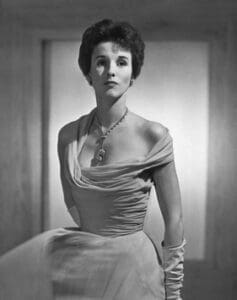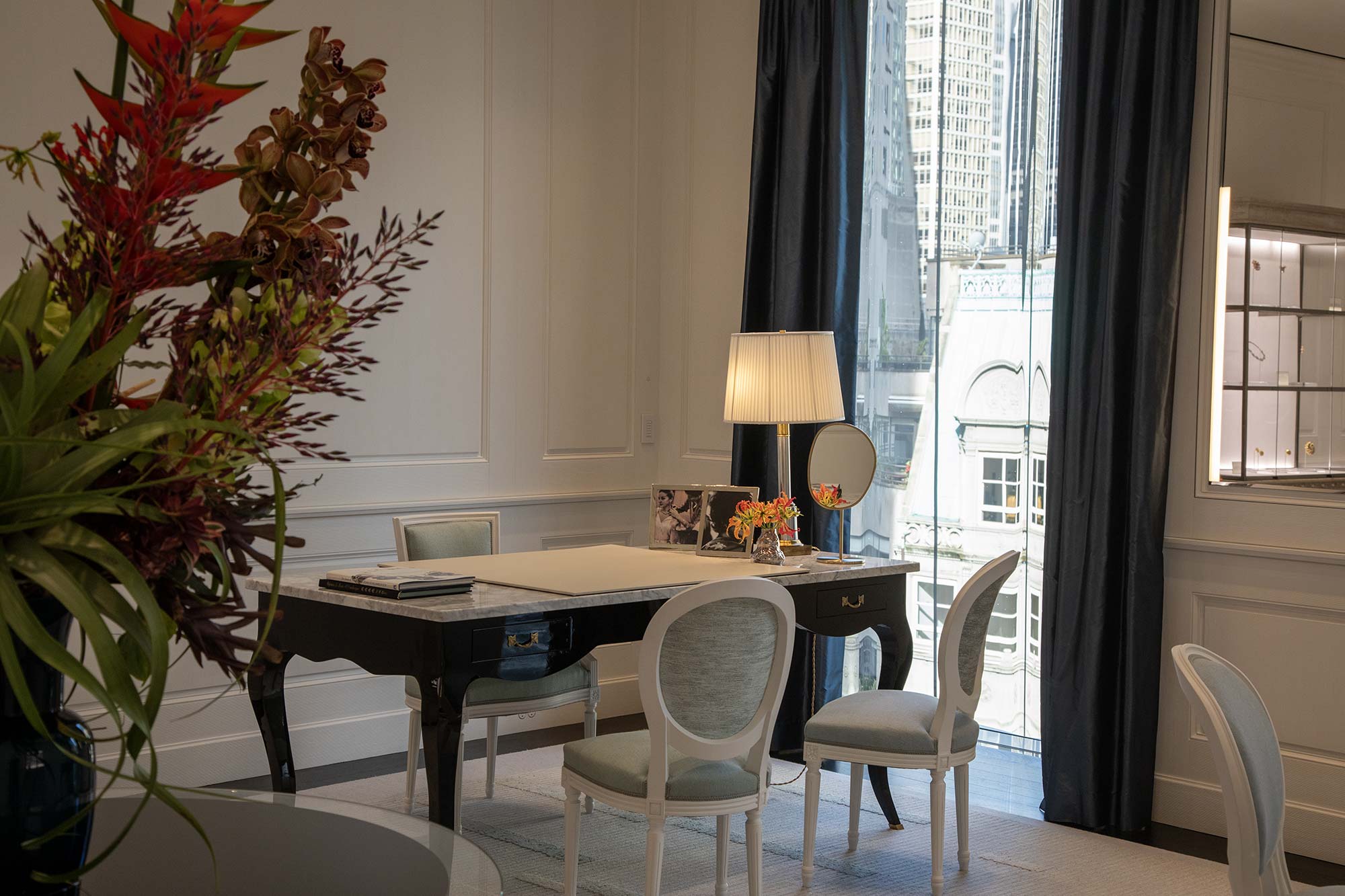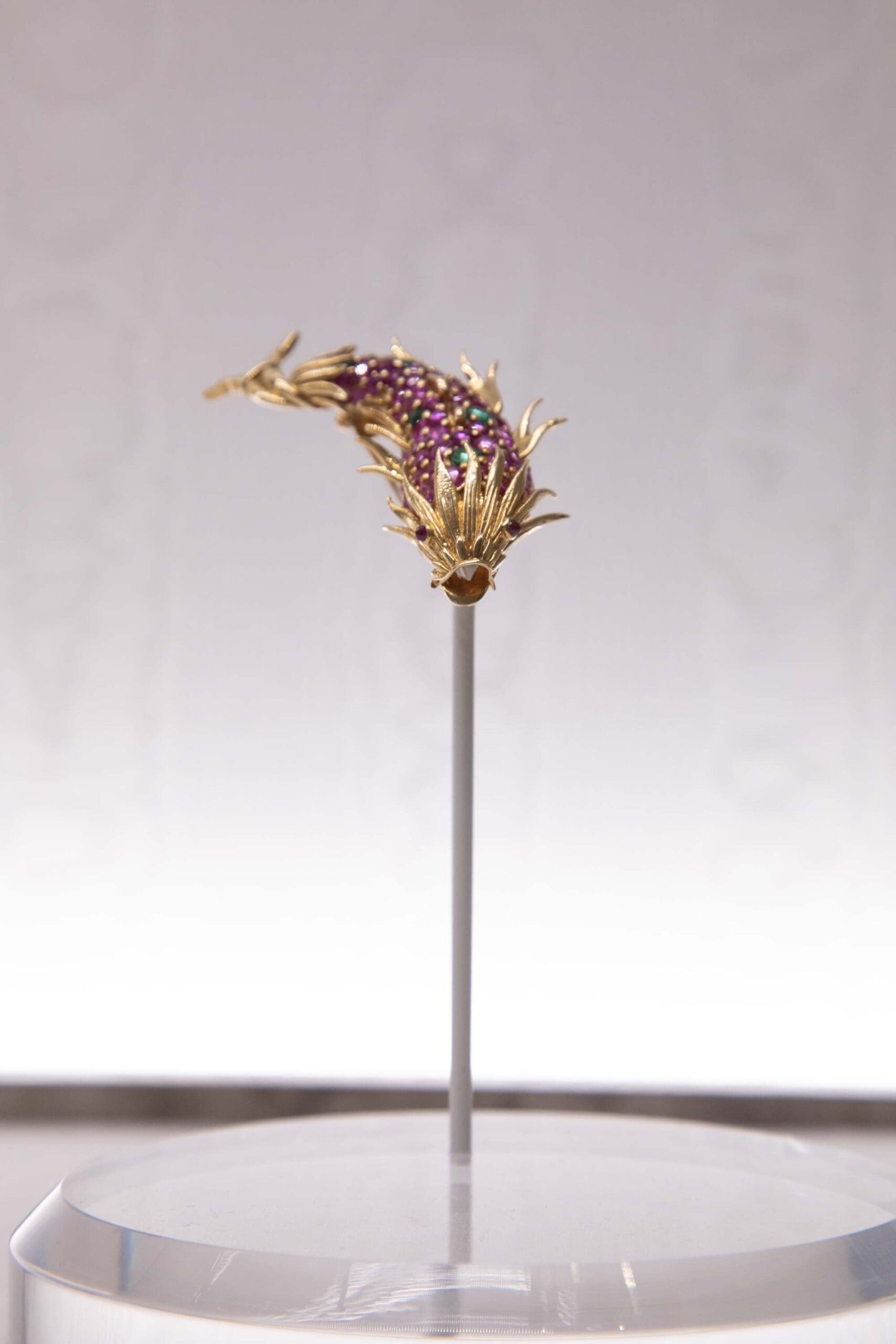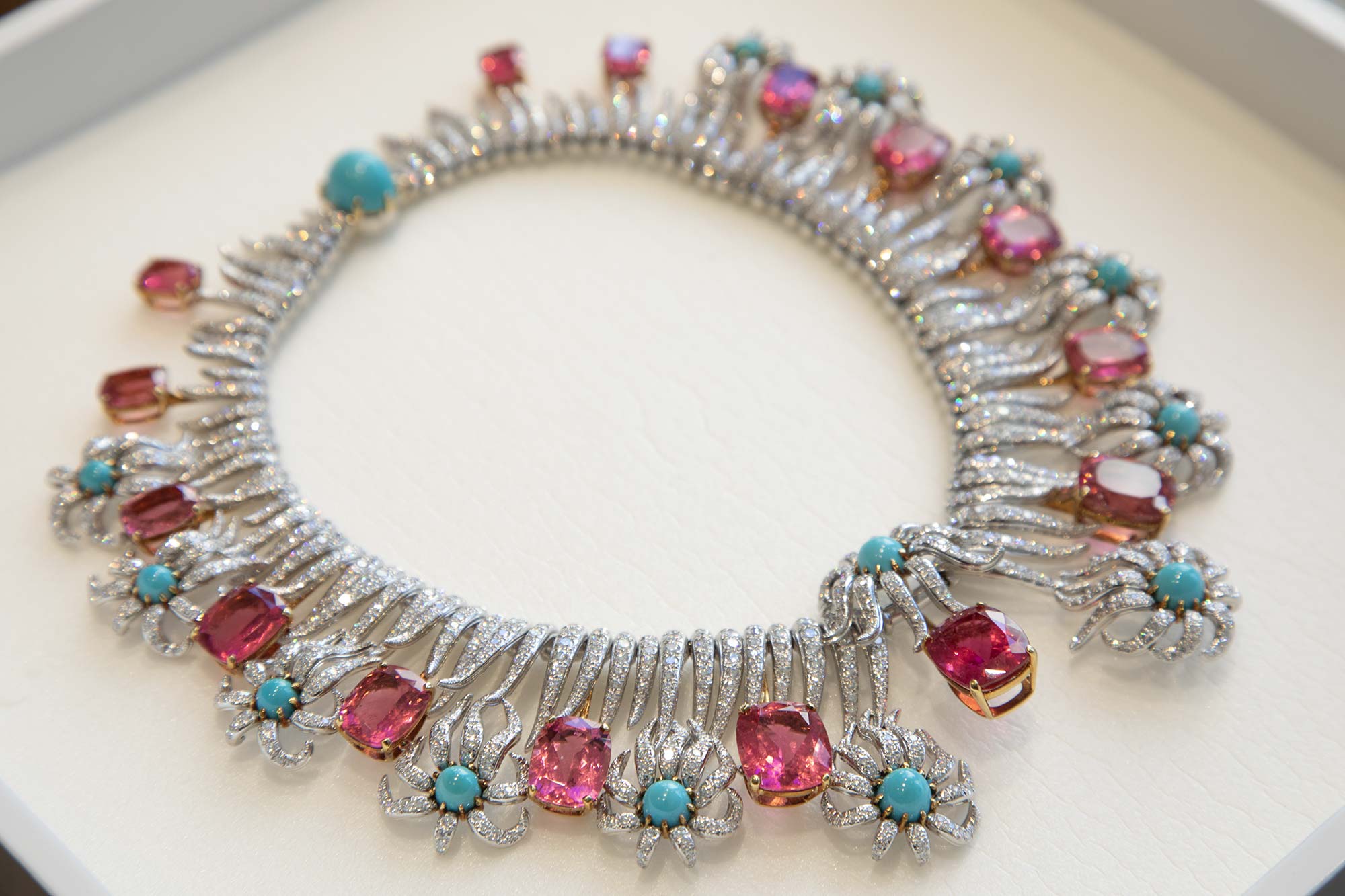Jean Schlumberger: Sculpting Dreams in Gold and Gemstones
Jean Schlumberger’s jewelry transcends time, capturing the surreal beauty of nature and the fantastical in a way that few other designers have achieved.
This journal entry explores Schlumberger’s legacy as one of the most imaginative jewelry designers of the 20th century, tracing his inspirations, his rise at Tiffany & Co., and the lasting impact of his creations on both luxury fashion and art.

Salvador Dalí in 1965, captured in a moment of whimsy by photographer Roger Higgins. Dalí’s surrealist works, which blurred the line between reality and fantasy, influenced an entire generation of artists, including Jean Schlumberger. Source: Wikimedia Commons, Public Domain.
For me, Schlumberger’s work first became a point of fascination in art school, when I found myself immersed in the surreal world of Salvador Dalí. Schlumberger and Dalí both moved within the avant-garde circles of 1930s Paris, collaborating with designers like Elsa Schiaparelli and pushing the boundaries of their respective arts. Their creations, though different in medium, shared an otherworldly quality—a daring vision that blurs the line between reality and fantasy. It was through this connection that Schlumberger became not just a designer, but a storyteller, using gold, enamel, and gemstones as his canvas.
Years later, I had the opportunity to help give Schlumberger a voice—quite literally—through the project The Voice of Schlumberger at Tiffany’s flagship store. Though no recordings of his actual voice exist, we created a soundscape that captured the essence of his art.
Let’s journey through Jean Schlumberger’s early life in France, where his inspirations first took root, and explore his rise to prominence at Tiffany & Co. We’ll dive into the whimsical world of his designs—creations that drew from nature’s wonders and transformed them into wearable fantasies. From Jean’s iconic collaborations with high-society figures like Jacqueline Kennedy to his lasting influence on modern jewelry, we love Schlumberger’s contribution to the world of art and luxury.
Through this exploration, we’ll understand why, even in silence, Schlumberger’s voice continues to resonate—through the gems he touched and the legacy he left behind, whispering to the dreamers who dare to see the extraordinary in the everyday.
Forward by Executive Creative Director, Chris “MUG5” Maguire
MAIN IMAGE: A dynamic, abstract portrait of Jean Schlumberger, designed to represent his visionary contributions to jewelry design at Tiffany & Co. and beyond. Created by MUG5 for RIOT.
“I try to make everything look as if it were growing, uneven, organic. I want to capture the irregularity of the universe.”
Blooming Dreams: The Untamed Origins of Jean Schlumberger
Born in 1907 in Mulhouse, France, Jean Schlumberger was raised amidst the structured world of textile manufacturing. Yet, even as his family’s wealth was woven from fabric, Jean’s heart was captured by the untamed beauty of nature. From the earliest moments of his childhood, he found solace not in the industry surrounding him, but in the delicate wings of a butterfly, the winding tendrils of plants, and the creatures of the sea. His imagination often took him into these hidden worlds, where the ordinary transformed into something magical.

Lucien Lelong in 1925, the celebrated French fashion designer who played a key role in shaping Jean Schlumberger’s early career. Lelong’s tutelage introduced Schlumberger to the world of haute couture Maison, where he began experimenting with turning everyday objects into intricate, wearable art. Source: Wikimedia Commons, Public Domain.
Though his parents hoped for him to follow a more traditional path, their encouragement toward practicality could not tame Schlumberger’s wild creativity. Instead of surrendering to convention, he would spend hours drawing flowers, animals, and sea creatures. These sketches—lively, whimsical, and imbued with a sense of fantasy—would later serve as the first seeds of his distinctive design language, where every curve seemed to flow with life.
Schlumberger’s first foray into the world of high fashion began under the tutelage of Lucien Lelong, a renowned Parisian couturier. It was here that Schlumberger began experimenting with turning ordinary objects, like Meissen porcelain flowers from chandeliers, into intricate jewelry. This early work was a precursor to the whimsical designs he would later create, transforming everyday materials into luxury art.
In the 1930s, Schlumberger followed his heart to Paris, a city teeming with creative energy and bursting at the seams with artistic revolution. Here, he would forge connections with leading figures of the avant-garde, including the inimitable Elsa Schiaparelli. What began as a humble venture into fashion—designing fantastical buttons for Schiaparelli’s haute couture—soon blossomed into something far greater. His eye for detail, his deep understanding of nature’s mysteries, and his ability to channel surrealism into wearable art began to take root in the world of Parisian fashion.

Portrait of Elsa Schiaparelli, the visionary Italian fashion designer, known for her bold and avant-garde designs. Source: Wikimedia Commons, Public Domain.
The Paris of the 1930s was also the Paris of the surrealists. Though Schlumberger never formally joined the movement, its influence was impossible to ignore. His designs, like the works of Salvador Dalí, twisted reality into something fantastical. The creatures he sculpted from gold and gems were nature reimagined, thriving in a world where the impossible became real. Sea creatures became ethereal beings, and blossoms that shimmer with a hidden life of their own. His work was never static; it danced between the realms of reality and dream, making it clear that Schlumberger was not just a jeweler—he was a storyteller.
These early years marked the first chapter of Schlumberger’s artistic odyssey. Fueled by the wonders of the natural world and the electric atmosphere of Paris, he began to create pieces that were living, breathing fantasies that would come to define his career for decades to come.
“Schlumberger was uninhibited in his conceptualizations of flora and fauna, at once representing and creating a unique fusion of natural forms. His magnificent creations are enduring icons.”
Between Paris and New York: Schlumberger’s Path to Global Acclaim

Schiaparelli Haute Couture Pine Cone Necklace, designed by Jean Schlumberger. This extraordinary piece highlights Schlumberger’s ability to merge whimsy with luxury, making it a highly coveted piece in fashion history. Available for purchase via 1stdibs.
As the 1930s came to a close, Jean Schlumberger’s name had already become synonymous with avant-garde creativity. His early partnership with Maison Schiaparelli was instrumental in his rise. Originally tasked with designing whimsical buttons for Schiaparelli’s haute couture, Schlumberger soon became a vital part of her collections, contributing jewelry pieces that reflected their shared love for surrealism and fantasy.
During his time with Schiaparelli, Schlumberger crafted innovative designs that went beyond functionality. One of his creations from this period was the Pine Cone Necklace, where gilded pine cones hung from a luxurious ribbon, exuding both natural beauty and high elegance. This piece captured the playful surrealism of the era and Schlumberger’s unique ability to blend fantasy with fine craftsmanship.
With support from prominent figures like Diana Vreeland, Schlumberger’s work began to appear more frequently in fashion magazines such as Vogue, Harper’s Bazaar, and Town & Country, further expanding his reach across Europe and into the United States.

Portrait of Babe Paley, New York socialite and fashion icon. Known for her impeccable style and social influence. Source: Wikimedia Commons, Public Domain.
During this period, Schlumberger perfected his signature style, taking inspiration from nature but always adding a surrealist twist. His jewelry featured playful reinterpretations of flora and fauna: delicate blossoms with gemstones for petals, marine creatures brought to life in enamel and gold, and celestial motifs that seemed to dance on the wearer’s skin. These creations were coveted by high society, leading to commissions from prominent families across Europe and America.
Babe Paley and other New York elite embraced Schlumberger’s designs as symbols of both wealth and artistic daring. As his international reputation grew, his creations became the focal point of conversation at glittering soirées and high-society galas. His clients, often aristocrats and movie stars, saw his pieces as more than just jewelry—they were wearable expressions of imagination and opulence.
By the late 1940s, Schlumberger had firmly established himself as a force within the fashion and fine jewelry worlds. His ability to blend nature’s beauty with a dreamlike sense of fantasy made him stand apart from his contemporaries. This momentum carried him into the next decade, setting the stage for his iconic work at Tiffany & Co. in the 1950s, where his imaginative spirit would flourish like never before.
Gems of Imagination: Schlumberger’s Masterpieces at Tiffany
By the mid-1950s, Jean Schlumberger found his ultimate creative home at Tiffany & Co., invited by the visionary Walter Hoving. This partnership marked a defining era for both the designer and the brand, as Schlumberger brought his daring imagination to one of the world’s most iconic jewelry houses. In his private studio on the mezzanine floor of Tiffany’s flagship store, Schlumberger conjured breathtaking designs, drawing deeply from the natural world, yet always infusing them with his surreal and fantastical vision.

The newly designed Schlumberger salon at Tiffany’s flagship store. This modern interpretation was inspired by Jean Schlumberger’s original salon, offering visitors an immersive experience that echoes the elegance and creativity of the legendary designer. Photographed by Nick Hudson for RIOT & The Tiffany Archives.
Schlumberger’s genius lay not just in his ability to craft beautiful pieces but in the way he used jewelry as a medium to tell stories. His works at Tiffany went beyond mere ornamentation; they were lively, sculptural masterpieces. Birds delicately perched on gemstones, sea creatures shimmered with the hidden magic of the ocean, and flowers seemed to bloom from gold and enamel. Each piece bore the hallmark of Schlumberger’s vision: an almost poetic exploration of nature. He once said, “I try to make everything look as if it were growing, uneven, organic”.

The intricate Seahorse Brooch by Jean Schlumberger for Tiffany & Co., crafted with gold, peridots, diamonds, and a ruby eye, exemplifies the designer’s ability to capture the elegance of marine life. Photographed by Nick Hudson for RIOT & The Tiffany Archives.
Schlumberger’s arrival at Tiffany was nothing short of transformative. His distinct artistry quickly attracted the attention of high society, including iconic figures like Jacqueline Kennedy and Elizabeth Taylor. His pieces became staples for the world’s elite, and his signature creations—like the paillonné enamel Croisillon bracelets—were celebrated for their vibrant colors, intricate designs, and superb craftsmanship.
“Schlumberger’s work drew the attention of high society, from Hollywood actresses to European royalty. His creations remain some of the most coveted jewelry pieces in the world.”

Jean Schlumberger jewelry pieces, including an intricate pink gemstone brooch and gold-enamel bracelets, showcasing his masterful ability to blend nature and fantasy. Photographed by Nick Hudson for RIOT & The Tiffany Archives.
Schlumberger’s collaborations with Tiffany’s master craftsmen ensured that his bold visions could be brought to life with technical perfection. Each piece was a meticulous fusion of his imagination and the artisans’ skill. Together, they pushed the boundaries of jewelry design, allowing Schlumberger to transform delicate ideas into wearable fantasies.
One of Schlumberger’s greatest masterpieces for Tiffany was the reinvention of the 128.54-carat Tiffany Diamond. This legendary gem, which had captured imaginations for decades, found new life under Schlumberger’s artistic direction. Most notably, it was showcased in a Ribbon Rosette necklace worn by Audrey Hepburn in the publicity shots for Breakfast at Tiffany’s, a moment that became iconic not only in film history but in the legacy of Tiffany & Co.
Beyond his public acclaim, Schlumberger’s artistry was profoundly personal. He worked hands-on with his team, ensuring that every piece, whether a whimsical brooch or a breathtaking necklace, was imbued with the same perfectionism he demanded in his sketches. His sketches were often delicate, detailed, and full of life, mirroring the intricate designs that would later be crafted from precious metals and gemstones. Many of these original designs, now part of Tiffany’s archives and various museum collections, are works of art in their own right.
“When Schlumberger began his tenure at Tiffany & Co., one of his first artistic moves was to mount the famous Tiffany Diamond on a high jewelry design… a bold move that solidified his artistic role at Tiffany.”
Schlumberger’s iconic Bird on a Rock design stands as perhaps his most celebrated creation. The delicate juxtaposition of a whimsical bird atop a brilliant gemstone captured the essence of Schlumberger’s playful yet sophisticated style. This design not only showcased Schlumberger’s technical brilliance but also his ability to balance whimsy and grandeur, making it a quintessential example of high jewelry.
Schlumberger’s process was meticulous. His paillonné enamel technique, for example, was laborious and required incredible precision. Fine gold foil was layered beneath the translucent enamel, then fired at high temperatures to achieve a vibrant finish. This technique gave his work an unparalleled depth, as seen in his famous Croisillon bracelets and other pieces inspired by nature.
From marine life to blossoming flowers, Schlumberger reimagined the natural world with a surreal twist, evoking a sense of wonder in every piece. He was, in many ways, a jeweler for dreamers. His work drew collectors and admirers alike into a fantastical world where the sea teemed with magical creatures, and where blossoms shimmered with a life of their own. He took risks, always pushing boundaries, transforming everyday flora and fauna into extraordinary works of wearable art.

The Jean Schlumberger Fish Brooch, a Tiffany & Co. creation, showcases Schlumberger’s playful take on marine life, featuring intricate gold detailing and colorful gemstones. This piece embodies his signature blend of fantasy and natural inspiration. Photographed by Nick Hudson for RIOT & The Tiffany Archives.
In 1995, the Louvre Museum in Paris paid tribute to Schlumberger with the exhibition A Diamond in the City. This prestigious retrospective was a fitting acknowledgment of Schlumberger’s profound influence on both art and fashion. His works, already revered in the world of jewelry, had transcended their utilitarian origins to become recognized as true works of art—worthy of being displayed alongside masterpieces by the world’s greatest artists.

A stunning custom necklace designed by Jean Schlumberger, featuring vibrant pink gemstones, turquoise, and diamonds, captured in brilliant detail by photographer Nick Hudson for RIOT & The Tiffany Archives. The intricate craftsmanship and bold color choices reflect Schlumberger’s iconic ability to merge nature and fantasy in his jewelry. Source: RIOT NYC.
Schlumberger’s legacy at Tiffany & Co. is unmatched, both in its creativity and its craftsmanship. His designs remain highly sought after by collectors and jewelry aficionados, and modern-day Tiffany continues to honor his vision through reissues and reinterpretations of his most iconic pieces. Even decades after his passing, Jean Schlumberger’s imaginative voice resonates in every gemstone he touched, every intricate detail he conceived. He was, and remains, one of the greatest jewelry designers in history, a visionary who taught the world that jewelry could not only adorn the body but also tell stories of dreams, nature, and fantasy.

A luxurious Jean Schlumberger gold watch designed for Tiffany & Co., showcasing his intricate attention to detail in both form and function. Photographed by Nick Hudson for RIOT & The Tiffany Archives.
Enduring Legacy: The Art That Still Whispers
Even decades after his passing, Jean Schlumberger’s work continues to illuminate the world of fine jewelry and art. His intricate creations—rooted in nature yet bursting with fantasy—remain timeless. Today, Schlumberger’s pieces are highly coveted by collectors, often fetching millions at auctions held by prestigious houses like Sotheby’s. These jewels, more than just accessories, have become cultural artifacts, cherished not only for their beauty but for the imaginative worlds they encapsulate.

Sotheby’s auction listings showing various Jean Schlumberger items for sale, including a gold, diamond, sapphire, and enamel brooch, as well as a platinum and diamond bracelet. Screenshot captured in October 2024.
Renowned museums, such as the Louvre and the Victoria and Albert Museum, have honored Schlumberger’s contributions to both jewelry and art by showcasing his masterpieces. His works have transcended the world of fashion, earning a place in the halls of great artistry. Schlumberger’s designs defy time and are living, breathing works of art.
In modern-day Tiffany & Co., Schlumberger’s legacy remains alive and integral. His designs are still celebrated and reimagined in the brand’s high-end collections, where pieces like the Bird on a Rock and Croisillon bangles are reissued for new generations of collectors. Tiffany’s flagship store, home to the Schlumberger Salon, offers visitors a chance to immerse themselves in his fantastical world. The Salon, designed in his honor, bridges the past and present by giving life to Schlumberger’s original creative spirit within Tiffany’s modern luxury landscape.

The Jean Schlumberger Salon at Tiffany’s new flagship store, showcasing a serene desk setup with a photograph of Jacqueline Kennedy. This intimate moment connects the legacy of Schlumberger’s designs to one of his most famous clients. Photographed by Nick Hudson for RIOT & The Tiffany Archives.
Tiffany’s current Design Director, Reed Krakoff, once described Schlumberger’s work as “elevating the everyday to the extraordinary,” underscoring the timeless relevance of his imaginative artistry. Schlumberger’s signature combination of vibrant colors, surrealist designs, and nature-inspired elements continues to influence contemporary jewelry designers. His visionary legacy ensures that Tiffany remains at the forefront of high jewelry, where artistry and craftsmanship converge.

An exquisite fish motif piece by Jean Schlumberger, likely a lighter or brooch, featuring his characteristic gold craftsmanship and intricate marine life detailing. Photographed by Nick Hudson for RIOT & The Tiffany Archives.
Schlumberger’s creations redefined luxury jewelry. His fantastical pieces allowed him to stand apart, transforming high society’s perception of luxury. His designs were wearable expressions of nature, fantasy, and wonder. Schlumberger’s legacy, nurtured by Tiffany, continues to inspire collectors and artists alike, as his creations move between the worlds of fashion, art, and culture.
A Legacy Continued: RIOT’s Journey with Tiffany & Co.
At RIOT, we’ve always been drawn to the visionary work of Jean Schlumberger, whose creations at Tiffany & Co. transcended the conventional boundaries of jewelry design. It is this enduring admiration that has guided our own collaborations with Tiffany, ensuring that Schlumberger’s fantastical world continues to enchant and inspire new generations.

A beautiful display of Jean Schlumberger’s brooches and necklace, featuring vibrant gemstones and exquisite craftsmanship. Photographed by Nick Hudson for RIOT & The Tiffany Archives.
One of our most celebrated projects, The Voice of Schlumberger, stands as a testament to this legacy. In an innovative tribute, we crafted a soundscape that brought Schlumberger’s creations to life at Tiffany’s flagship store. Although no recordings of Schlumberger’s voice exist, we captured the spirit of his art, creating an immersive experience where his voice could be felt through every piece on display. This project reflected the whimsy and fantasy that Schlumberger infused into his designs, allowing visitors to connect with his world in a deeply personal way.

A dynamic, abstract portrait of Jean Schlumberger, designed to represent his visionary contributions to jewelry design at Tiffany & Co. and beyond. Created by MUG5 for RIOT.
Beyond this project, RIOT has continued to honor Schlumberger’s legacy through our ongoing creative collaborations with Tiffany & Co. Our team has had the privilege of photographing and showcasing some of the brand’s most iconic pieces, including those that Schlumberger himself designed. Through our lens, we’ve sought to reveal the delicate artistry of each piece, highlighting how Schlumberger’s visionary designs remain as vibrant today as they were in his lifetime.
Our creative partnership with Tiffany goes beyond just celebrating the past. We’ve worked with the brand on multiple projects to capture the essence of timeless luxury and forward-thinking design. From documenting the elegance of Tiffany’s latest collections to curating historical stories, we aim to fuse Sthe brand’s historical impact with the modern, innovative spirit of Tiffany today.
At RIOT, we believe that Schlumberger’s legacy is one that will continue to inspire artists, dreamers, and collectors for generations to come. Through our ongoing collaborations with Tiffany, we’re proud to play a role in preserving and elevating that legacy. Explore our full range of work with Tiffany here.




